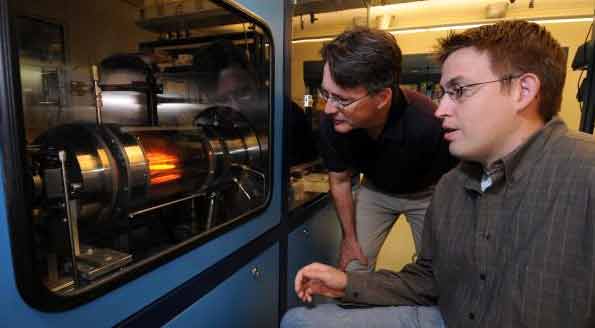Scientists overcome technical problems, low-energy solid-state lighting is about to become a reality The light-emitting technology called light-emitting diode is four times the luminous efficiency of traditional incandescent lamps. At the same time, it has extremely superior environmental protection compared with fluorescent lamps. Its service life is also quite long, generally about fifteen years. "This LED technology, due to its better lighting and environmental friendliness, will probably be a complete replacement for today's incandescent and fluorescent lamps," said Timothy D. Sass, Ph.D. in Materials Engineering, Electronics and Computer Engineering. ." Such an LED lighting device will have the same efficiency as a fluorescent lamp, but the former does not contain harmful substances such as mercury contained in the latter. Despite the many advantages of this type of lighting device, its market price is too high because its materials are derived from sapphire. Researchers have found a way to solve this problem by using metal-coated silicon instead of the original material, which reduces the cost. A detailed description of the material will be published this month in the US Physics Bureau's Applied Physics Letters. Such a light-emitting diode device is made by the nature of energized light emission of a semiconductor material, and belongs to solid-state illumination, while conventional illumination is realized by lighting a wire and a luminescent gas in a glass tube. The device was used only for the indicators of electronic devices and toys because of technical limitations, but the introduction of new materials now makes the illumination the same as fluorescent lamps. This new material is mainly a marrying compound. It emits light in sapphire blue and green after being energized, so it is often used in traffic lights and lasers of high quality DVD players. In the study of new silicon light-emitting diodes, Purdue engineers metallized the silicon plate and wrapped a reflective layer of zirconium-nitrogen compound to achieve the same reflective effect. "When the LED device emits light, the light is emitted in different directions, and some are upwards and downwards. We need to reflect the downward light upwards so that the light will not be lost," said Sas. Initially, zirconium compounds were not stable in silicon because of the chemical reaction between the two. The researchers solved this problem by using a method of adding aluminum nitrogen compounds between silicon and zirconium nitrogen compounds. "The main benefit of this process is that we successfully isolated the two (silicon, zirconium nitrogen compounds) to prevent the two reactions," said Sas. Despite the use of this technology, engineers are still unable to efficiently produce such LED devices made from silicon-containing reflective layers. The method currently used is a common method in the electronics industry, in which zirconium and aluminum metal particles are collided with a positively charged argon ion in a vacuum tube, and argon ions will cause metal particles to fly out. However, if this reaction is placed in a nitrogen atmosphere, the resulting zirconium nitride compound and aluminum nitrogen compound can be coated on the surface of the silicon. When these compounds are all covered on the silicon surface, they automatically align the crystal structure to correspond to the silicon structure. "We call this reaction to grow in the opposite direction. The particles of the compound in the reaction will flow on the silicon particles until a suitable crystal position is found," Sas said. It is precisely because of this crystal structure mode that the LED can work normally. The use of silicon materials accelerates the production process of LED devices while reducing the cost of many instruments. Another advantage of the sapphire is that it has a good heat dissipation effect, which can reduce the possibility of damage to the instrument due to overheating, making the use more stable and long-lasting. At the same time, the widespread use of solid-state lighting will have a huge impact on energy consumption, as almost one-third of the electricity consumed in the United States comes from lighting. “If we replace all lighting fixtures with solid-state lighting, one-third of the energy consumed by lighting can be saved,†Sas said. “This is 10% of the US electricity consumption. †In fact, incandescent lamps have a luminous efficiency of 10%, which means that 90% of the energy is used for heating, compared to the solid-state lighting device's luminous efficiency of 47%. About 64%, but the market price of this solid-state lighting device is now one hundred dollars. If the price drops to five dollars, it will soon be widely used. "This solid-state lighting device is still being improved, and it has advantages in all aspects. Although its price is now more expensive, this problem will be solved soon," said Sas. He expects that such solid-state lighting devices, which are inexpensive in two years, will be put on the market.
Medium Voltage Power Cables includes Single Core Medium Voltage Cable, Three Cores Medium Voltage Cable. They are used for power networks, industrial plants.
Generally, Medium Voltage Cables are Copper Wire conductor, Semi-conductor Shield, XLPE insulation, Semi-conductor Shield, Steel Wire Armored or Steel Tape Armored, with PVC sheath or LSOH Sheath.
We supply lots of those Cable as per IEC 60502 and other requirements. BDK is top supplier for China Southern Power Grid.
Medium Voltage Power Cables,Medium Voltage Cable,Cable Medium Voltage,Mv Cable Shenzhen Bendakang Cables Holding Co., Ltd , https://www.bdkcables.com
According to daily technology reports, researchers at Purdue University in the United States have recently overcome a major technical problem that will reduce the energy consumption of solid-state lighting. It is estimated that the widespread use of this technology will save 10% of electricity. Consumption.